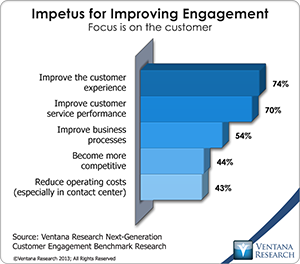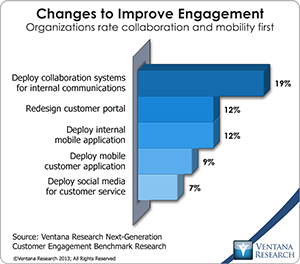In my benchmark research into next-generation customer engagement three-quarters (77%) of participating companies said it is necessary to improve the way they engage with customers.
In my benchmark research into next-generation customer engagement three-quarters (77%) of participating companies said it is necessary to improve the way they engage with customers. The main  drivers for doing that are to improve the customer experience (74%) and improve customer service (70%). However, neither is an easy task because companies now have to support more channels of communication, and more customer interactions are handled by multiple business units within the organization. The combined impact of this complexity can be inconsistent responses that depend largely on which channel the customer uses and which person handles the interaction. This is situation is likely to get worse as customers continue to use existing channels but increasingly add new means of engagement such as mobile apps, voice-activated applications and social media posts.
drivers for doing that are to improve the customer experience (74%) and improve customer service (70%). However, neither is an easy task because companies now have to support more channels of communication, and more customer interactions are handled by multiple business units within the organization. The combined impact of this complexity can be inconsistent responses that depend largely on which channel the customer uses and which person handles the interaction. This is situation is likely to get worse as customers continue to use existing channels but increasingly add new means of engagement such as mobile apps, voice-activated applications and social media posts.
The research shows that companies to expect keep on adding channels, including, despite predictions to the contrary, small numbers of companies expecting to add traditional channels such as the telephone, email and written documents. While innovative channels such as social media (40%), chat (41%), mobile business apps (37%), mobile customer service apps (29%) and video calls (29%) are currently used by a minority of companies, they are the ones more companies expect to support in the next two years. This is especially true of mobile customer service apps, which an additional 40 percent expect to deploy, mobile business apps (38%) and social media forums (35%). They are also where companies expect to see in the most increase in the volume of interactions: 30 percent of companies expect significant growth in social media, and 24 percent expect growth for each type of mobile apps. At the same time companies cannot afford to forget more established channels; for example, more than one-fifth expect significant growth in the use of Web-based self-service, their customer portal and email. In total, the research makes clear that companies must support as many channels as possible; if they haven’t already begun supporting social customer service (as opposed to using social media merely as a cheap form of marketing) and mobile apps, they should start to do so soon.
Among companies that now support social media, only one-fifth said their efforts have been successful. As a pointer to others thinking of supporting social media, these companies said that to be more successful they must provide more information (48%), link social customer service processes with other processes (41%) and personalize more responses (41%). Although support of mobile apps is in its infancy, just under one-third of companies said their customers provide positive feedback about such apps; perhaps even more pleasingly they have seen improved customer satisfaction (42%) and customer effort (40%) scores and fewer calls to the contact center (33%). It is early for truly social customer service and mobile apps, but these results show they are likely channels for the future. Our advice is not to waste time and begin supporting them but very importantly, design them with the customer in mind.
There is a lot being written about the “omni-channel customer experience” today, but until companies fully integrate management of all their communication channels, I don’t believe customers will receive consistent experiences across them. And as I indicated earlier, there is another barrier. This research confirms what I have seen in previous benchmarks: Nearly all business units, except for IT, are now involved in handling customer interactions, and these business units are as disconnected as are the communication channels. Marketing, sales, customer service and other business units all typically do their own thing, and this is another reason why customers are likely to get different information and experiences depending on who handles their interaction; it also makes it less likely that interactions will be resolved at the first attempt.  The solution is for business units to share information and collaborate more on the resolution of customer issues. The research finds that to improve engagement, most (19%) plan to deploy collaboration systems. Furthermore although the research finds that today companies mostly use traditional tools such as file sharing, workflow and alerts, these are likely to replaced with systems that support Facebook-like wall capabilities for more real-time sharing of information and dialogue between employees. Most interactions need handling in real time, and such capabilities can help improve first-contact-resolution rates and provide better customer experiences and outcomes.
The solution is for business units to share information and collaborate more on the resolution of customer issues. The research finds that to improve engagement, most (19%) plan to deploy collaboration systems. Furthermore although the research finds that today companies mostly use traditional tools such as file sharing, workflow and alerts, these are likely to replaced with systems that support Facebook-like wall capabilities for more real-time sharing of information and dialogue between employees. Most interactions need handling in real time, and such capabilities can help improve first-contact-resolution rates and provide better customer experiences and outcomes.
My research agenda for 2014 is focused on helping provide the best possible customer engagement methods using technology. The pace of change in the way consumers interact with each other and companies continues to accelerate, and companies that don’t keep up risk losing business. This and other consumer research shows that more interactions will be based on electronic channels, yet not many companies are prepared to meet these challenges. The technology is available, especially as more vendors support cloud-based systems, so I recommend companies don’t rest on their laurels but take the next steps toward a true omni-channel experience. If you want to learn more about how to best in class for customer engagement, let me know as we have the research and expertise to ensure you can do so.









